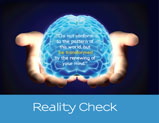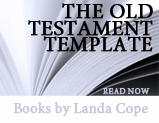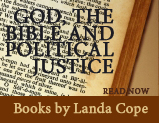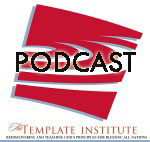God, the Bible and Political Justice: Chapter 7
Part Two: Moses and the Prescriptive Law
Chapter 7
The Template of Laws
Nowhere does the Law weave the values of the Kingdom more delicately and beautifully than when applied to public justice. It is so intricate that it is difficult to know which value thread to begin with in unweaving it. There are innumerable ways to look at and analyze what God is giving us in these passages. For our purposes in this volume on government and civil law I am using a matrix of three categories of crime: lose of life, bodily harm and lose of property and four categories of consequence: death penalty, life sentence, restorative and punitive. With these categories we can look at all that the prescriptive law stipulates as crime.
I picture the study of the Scripture as mentally unweaving the threads of an ornate tapestry in order to understand the parts that make up the whole. The threads do not stand by themselves; only together do they produce the picture. But the threads are the foundational parts of the whole and lay out the grid work that makes the tapestry possible. Like reverse engineering of flat box furniture, we take the whole of Scripture apart and figure out the elements God is emphasizing in order to understand it and make it easier to reassemble it back into our life.
In Deuteronomy chapter one, God initiates a revolutionary idea to curb man’s great appetite for violence and injustice. God makes the human race responsible for governing themselves. They will choose their leaders. They will choose the laws and they will choose consequences for breaking those laws. God will give Israel His thoughts on these subjects but the authority will be theirs to maintain or change their direction. Consensus, representative, bottom up political power is born.
Remember as we walked through Genesis, the consequences of sin, separation from God, are death… always. We all die physically because sin came into the world. As God continues in Genesis He hammers home the fruit of sin is death. We begin with brother killing brother and continue until the entire human race is so violent, that human life is endangered entirely. The flood and rebooting of human existence through Noah are God’s just and merciful option. But again man’s decent into violence in Abraham’s family is so rapid that in just three generations they have moved to near fratricide of Joseph and genocide of the Shecemites. A 435-year generational sentence is imposed on Israel as a nation in order to create an understanding of the value of human life.
Now God liberates and gives Israel the Law. The prescriptive parts of the Law are very clear. In essence God is saying, if you knew what I know, you would “purge this evil” from your society, because these are the very things that will lead to increasing violence and loss of life; sex, abuse of power and greed.
In other words, in the Law, God is telling us clearly how to create safe, life sustaining communities and making us responsible to do it. The burden of justice is now on our shoulders. We are free to change the laws God has given and we are free to evaluate the consequences, the fruit of our choices. Are we stopping violent deaths of our fellow citizens or is it increasing? Is our mercy succeeding where God’s has failed us? If not, something must be wrong with our choices.
Civil Law vs. Moral Law
In order to interpret the Laws of Moses and the history of Israel into our current events we must understand the difference between two God given authorities, the authority of “civil law” and that of “moral law.”
All “law” is moral in the sense that it says, “this is right and this is wrong.” In setting a standard of “acceptable behavior” we must make judgments of what is “good or bad.” But not all “morality” can be made a matter of civil “law.” By giving us responsibility to decide God makes us look at the implications of our choices by the impact on the society we live and raise our children in. Civil law, representing the people, will never be more moral than the majority of the people it represents. But, a more moral people will seek a higher level of civil law. There in lies the tension between the work of the Pastor and the work of the President.
Both civil and moral laws are given authority from God. But they are two different kinds of authority with two different functions. One must have the will of the people behind it in order to have the power to govern. The other must have the will of God behind it to have authority and the blessing of God. One reveals the standards of the people and the other reveals the standards of God. One must seek the support of the people or to change the thinking of the people in order to have authority. The other must ignore the thinking of the people and represent God alone in order to have authority. They are divinely disagreeable in the purposes of God. And we must have both to keep the Kingdom tension of justice in human society. Civil law must be continually committed to keeping the rights of both safeguarded. This is dilemma and divine tension.
The Template
The Law seems like a maze in part because of its circular story telling style. We see themes rotating and weaving throughout but they are difficult to grab hold of. Because I am dyslectic it is essential for me to order information to retain it. So I used color to help me again in this study of the Law as I did in the study of the Domains in the Introductory Volume. I divided out the prescriptive parts of the Laws of Moses. Those parts of the Law that tell us to “do this but do not do this,” like the 10 commandments. These “prescriptive” portions are found in Exodus, Leviticus, Numbers and Deuteronomy. Then beginning with Deuteronomy because it is considered by Jewish and Christian scholars to be the “core book,” I assigned each theme in the prescriptive law a color when it appeared in my reading and from then on used that same color each time that subject reappeared. Once I had used Deuteronomy to lay down the pattern I then was able to see what God emphasized or added to these themes in the other three books of the Law.
Five Values
To my surprise, I found that the entire prescriptive law builds on five core values that are repeated and supported in different circumstances and within different authorities. Here are the five values:
1. Life is sacred.
2. The material world is real, good and essential for all of life.
3. Words have power and we are accountable for them.
4. Everything needs and is redeemable.
5. Any thinking that takes us away from God’s truths and values will begin to curse (will not bless) us. (Idolatry)
Of course each of these values supports the first: “life is sacred.” And so all of them could be stated as “Life is sacred, therefore…”
Five Assumptions
In chapter five we laid down five assumptions that the Kingdom of God builds on. These are the realities Scripture presupposes:
1. God is and is who He says He is.
2. God is the Creator of the material universe, seen and unseen, and it is good.
3. Human individuals, male and female, are created in the image of God and His central purpose for all creation.
4. Everything that God has created is damaged by the fall of man and sin.
5. Everything that is damaged is redeemable through the blood of Christ.
I think most can see the similarities between the five values of the Law and the five assumptions that all of Scripture is built on.
Institutions of Authority
In chapter four we looked at four institutions of authority created by God:
1. Individual
2. Family
3. Government
4. Church[1]
The sovereign individual, created in the image of God is the foundational building block of the Kingdom. The sovereign family of husband, wife and children, is crucial to the development of healthy and mature individuals. The sovereign government, empowered by the people being governed is responsible to define and enforce God’s delegated authority, rights and responsibilities. And finally the sovereign Church is responsible to rightly represent God and His standards.
Each of these “institutions” is given a type of authority, jurisdiction, borders, rights, freedoms and responsibilities. These lay the foundation for and the value base of civil law. These values do not perfect human beings or societies but, to the level they are established and reinforced, they will create and sustain a more blessed society. These values and the institutions when applied reveal God to the human community. They work with the Cross to reveal Christ the King but they do not substitute for forgiveness and salvation through Jesus. They reveal the Kingdom that is coming but they cannot perfect that Kingdom on earth. Established and used properly these values produce a higher quality of life in all areas of life but they will not finally perfect man or creation.
We are beginning to identify the basic building blocks of God’s Kingdom and Biblical thought. They overlap, weave and repeat themselves over and over throughout Scripture. We must still add the themes of the Prophets and the New Testament writers, but the grid is taking shape. We have five assumptions on which God builds all His thinking. Five values that are essential to uphold if these assumptions are true and four institutional authorities that God gives us in order to preserve and perpetuate these truths and values for the purpose of blessing our lives and our communities.
Tension
These Biblical realities set up a “tension” of freedom, rights and responsibilities that must be maintained in order to maintain “right order” or “justice” and build healthy individuals, families and communities. They cannot be “balanced.” They must be mutually maintained.
Picture a tight rope. In order to be traversed it must be rigid. If there is any give at all the consequences can be catastrophic for the walker. This is far more consequential than a set of scales that are just a few grams off. The acrobatic artist cannot survive a slack rope. He can only perform when there is perfect tension on the rope.
In political justice if we error in one direction or the other we distort God’s order in His Kingdom. God has made the individual free and sovereign. But, since that is true of every individual, there are limits to freedom of any single individual. In order for every individual to be free there have to be limits to all of our freedoms. Who has the right and responsibility to create and sustain those boundaries? God has created the family as the authority for and over children. The authority of parents is loving their children. If they are trying to murder their children they are in violation of the sacredness and rights of the individual life. I have the freedom to believe what I like. Do I have the freedom to practice that freedom anywhere anytime any place? If I believe in human sacrifice for my blessing do I have a right to do it? Or is this an abuse of the sacrifice’s rights? Do we have rights as communities? How do we secure minorities rights, the rights of parents and children, and the freedom of faith while not destroying the rights of the community?
In every legal issue we are asking these questions:
1. To whom has God given what rights and responsibilities?
2. What are the limits of those rights?
3. How are violations of those rights to be dealt with?
Every system of governance has answers to these questions or is working on them. But are they Biblical answers? We can know what God says about each question and we can know, at any given time where our nations laws and system of governance are blessed or in danger, this is the Biblical Template. But we must be willing to exchange the thinking of the world even when it has been called “Christian” and replace it with God’s thinking, even when that is called “worldly.”
Working the Template
If we ask the Bible the question, “What does loving my neighbor look like?” we could look at the Ten Commandments. If we ask, “Why are these Ten Commandments important and how do I apply them?” we look at the whole of the Law for the details. If we ask, “What would happen to a society if we applied or moved away from these values?” we look at the Prophets. And if we ask, “How might a community begin to move away from God’s thinking?” we look at the history of Israel in the Law and the rest of the Old Testament.
For our purposes in this book, we look at the prescriptive and historical law as they relate to civil law and justice, trying to draw out what is emphasized. But for the development of our thinking we must see them as integrated and woven. So, in effect, we “dissect” to analyze and put them back together to understand and apply.
For example, the prescriptive law says that adultery is illegal and punishable by death. But historically this is not applied when David committed adultery with Bathsheba. Why? Did they just not apply the law? Or, was there more to “the Law” than just the prohibitions? Was the right of the people to ratify and change civil law part of what the values of “the Law” secured? When the Pharisees bring Jesus a woman caught in adultery and encourage Him to stone her according to the Law of Moses. Jesus encourages them to stone her if their righteousness will allow them to stand as judge. Under Roman law adultery was not illegal and if they had stoned her they would have been found guilty of murder. Perhaps this was their plan for Jesus. He then dismisses the women with the exhortation to “sin no more.” Adultery is still immoral.
[1] It is very tempting to make this list five as well by adding “God” from who all authority and power comes. The author is resisting the temptation to numerical perfection.







